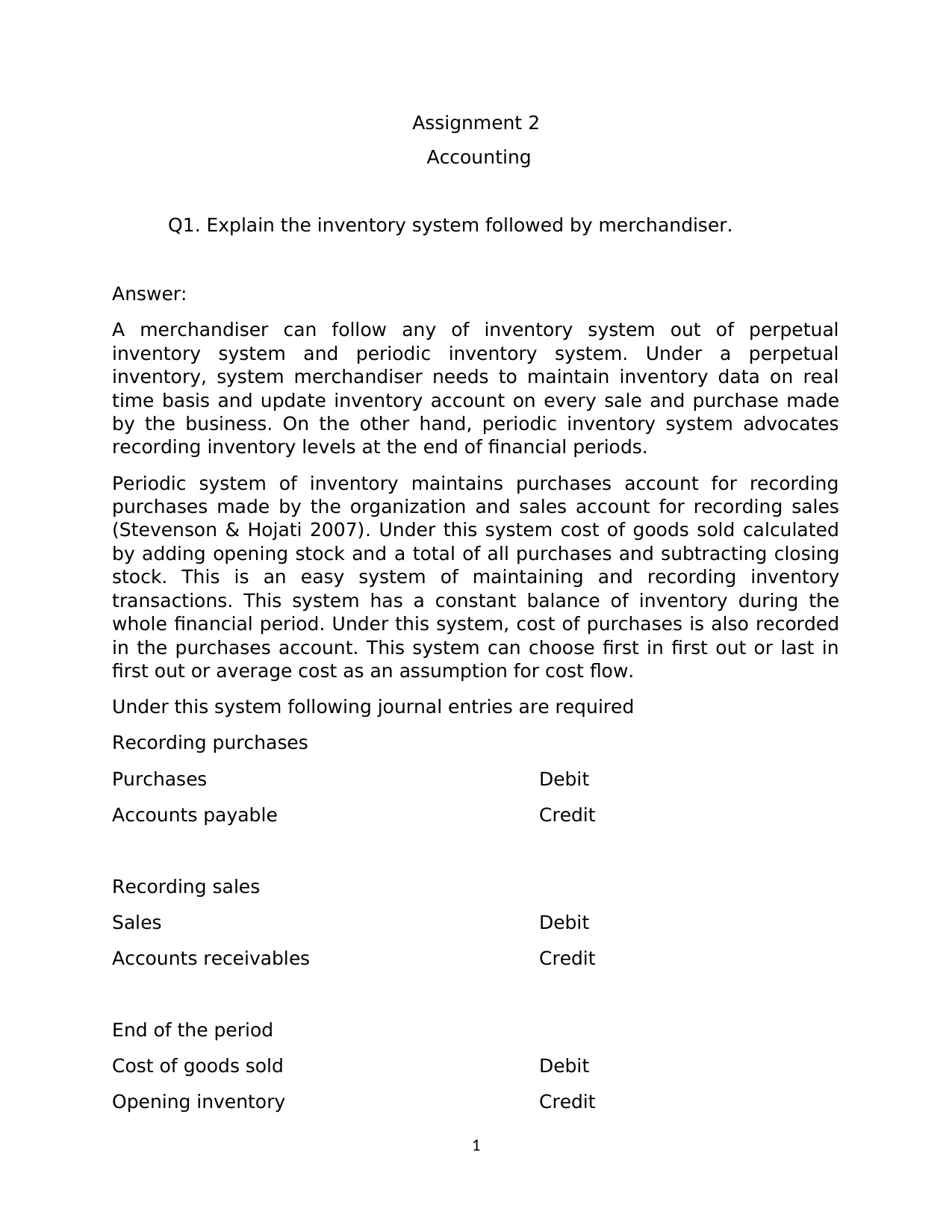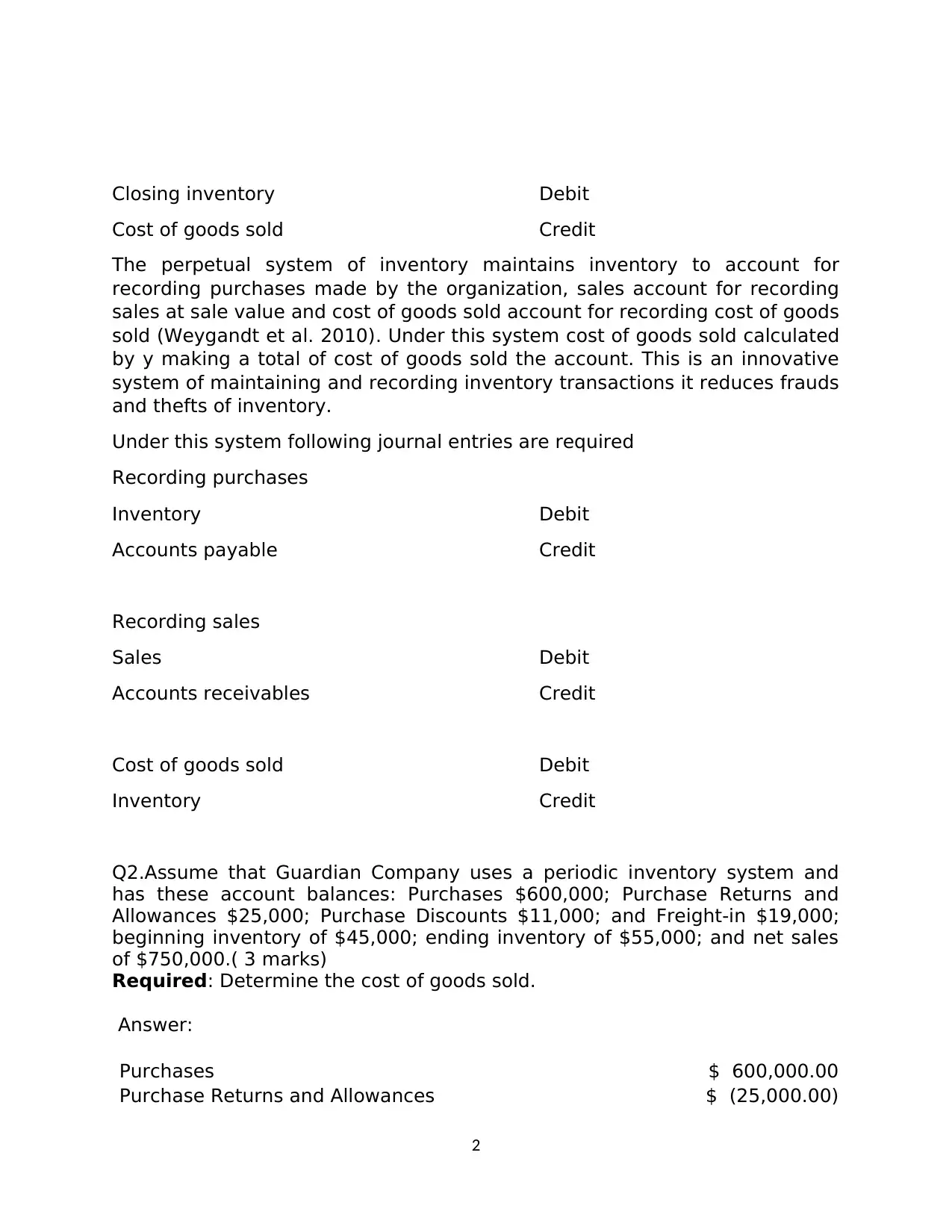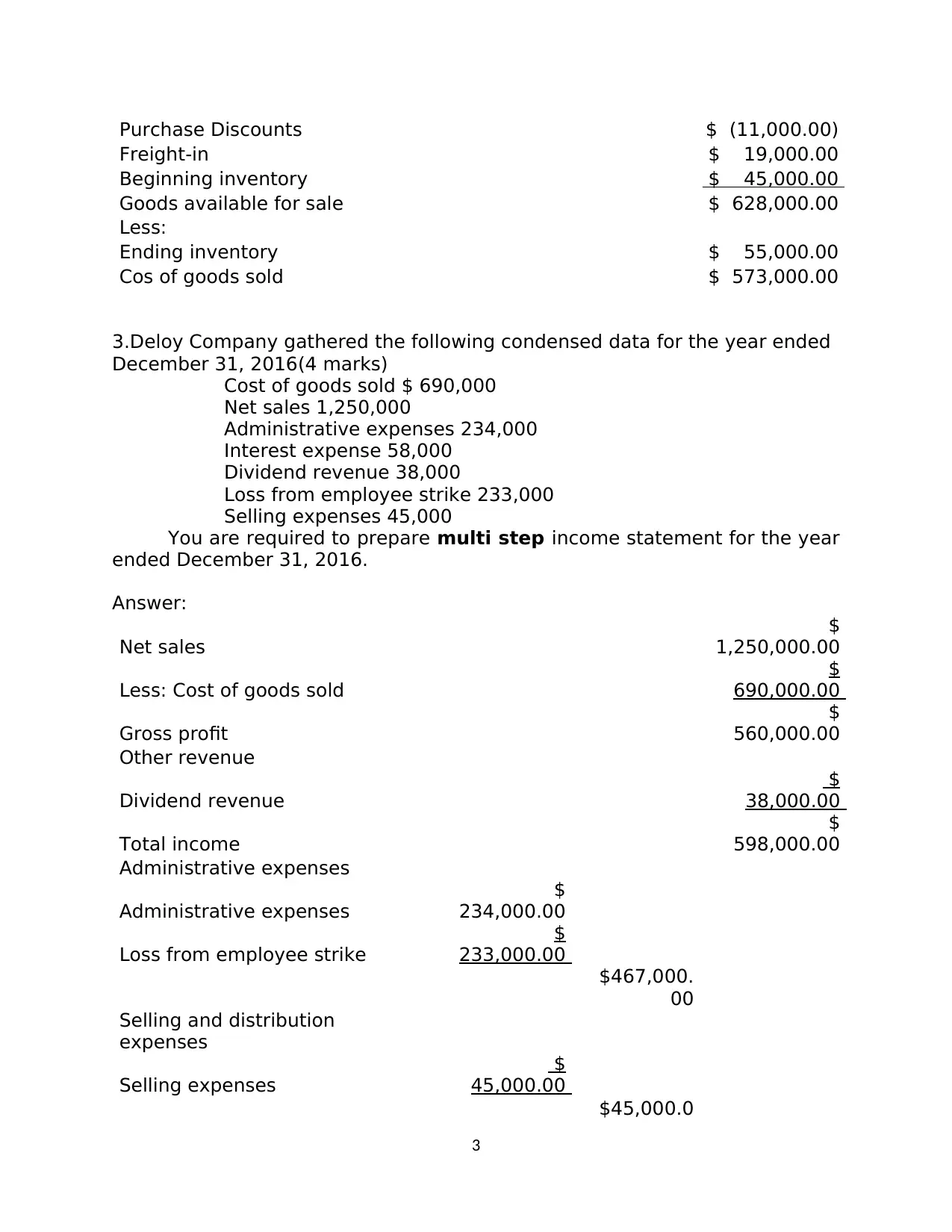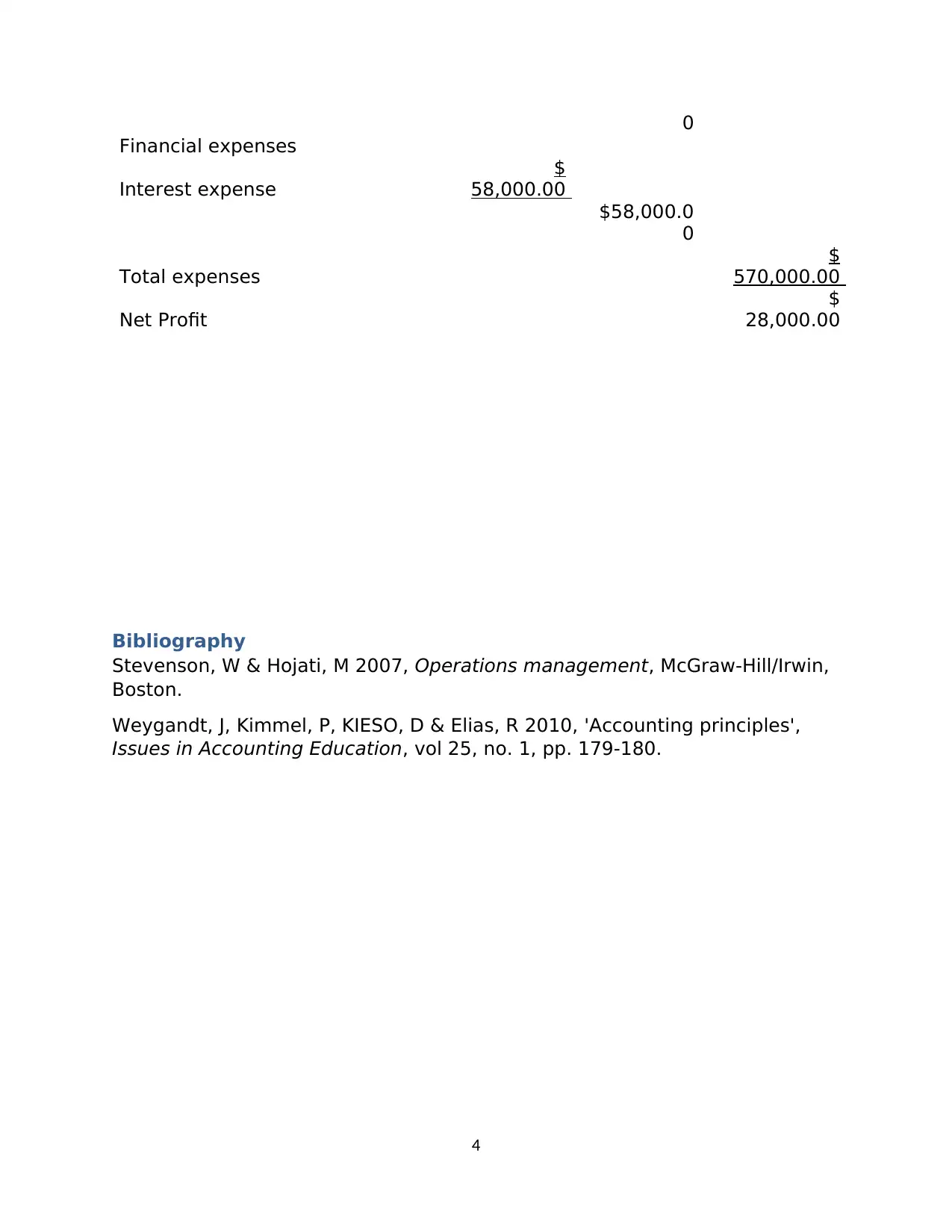Accounting Assignment 2: Inventory Systems and Financial Statements
VerifiedAdded on 2020/05/11
|4
|650
|129
Homework Assignment
AI Summary
This accounting assignment solution addresses two key questions related to inventory management and financial statement preparation. The first question explains the differences between perpetual and periodic inventory systems, detailing how each system records purchases, sales, and the cost of ...

Assignment 2
Accounting
Q1. Explain the inventory system followed by merchandiser.
Answer:
A merchandiser can follow any of inventory system out of perpetual
inventory system and periodic inventory system. Under a perpetual
inventory, system merchandiser needs to maintain inventory data on real
time basis and update inventory account on every sale and purchase made
by the business. On the other hand, periodic inventory system advocates
recording inventory levels at the end of financial periods.
Periodic system of inventory maintains purchases account for recording
purchases made by the organization and sales account for recording sales
(Stevenson & Hojati 2007). Under this system cost of goods sold calculated
by adding opening stock and a total of all purchases and subtracting closing
stock. This is an easy system of maintaining and recording inventory
transactions. This system has a constant balance of inventory during the
whole financial period. Under this system, cost of purchases is also recorded
in the purchases account. This system can choose first in first out or last in
first out or average cost as an assumption for cost flow.
Under this system following journal entries are required
Recording purchases
Purchases Debit
Accounts payable Credit
Recording sales
Sales Debit
Accounts receivables Credit
End of the period
Cost of goods sold Debit
Opening inventory Credit
1
Accounting
Q1. Explain the inventory system followed by merchandiser.
Answer:
A merchandiser can follow any of inventory system out of perpetual
inventory system and periodic inventory system. Under a perpetual
inventory, system merchandiser needs to maintain inventory data on real
time basis and update inventory account on every sale and purchase made
by the business. On the other hand, periodic inventory system advocates
recording inventory levels at the end of financial periods.
Periodic system of inventory maintains purchases account for recording
purchases made by the organization and sales account for recording sales
(Stevenson & Hojati 2007). Under this system cost of goods sold calculated
by adding opening stock and a total of all purchases and subtracting closing
stock. This is an easy system of maintaining and recording inventory
transactions. This system has a constant balance of inventory during the
whole financial period. Under this system, cost of purchases is also recorded
in the purchases account. This system can choose first in first out or last in
first out or average cost as an assumption for cost flow.
Under this system following journal entries are required
Recording purchases
Purchases Debit
Accounts payable Credit
Recording sales
Sales Debit
Accounts receivables Credit
End of the period
Cost of goods sold Debit
Opening inventory Credit
1
Paraphrase This Document
Need a fresh take? Get an instant paraphrase of this document with our AI Paraphraser

Closing inventory Debit
Cost of goods sold Credit
The perpetual system of inventory maintains inventory to account for
recording purchases made by the organization, sales account for recording
sales at sale value and cost of goods sold account for recording cost of goods
sold (Weygandt et al. 2010). Under this system cost of goods sold calculated
by y making a total of cost of goods sold the account. This is an innovative
system of maintaining and recording inventory transactions it reduces frauds
and thefts of inventory.
Under this system following journal entries are required
Recording purchases
Inventory Debit
Accounts payable Credit
Recording sales
Sales Debit
Accounts receivables Credit
Cost of goods sold Debit
Inventory Credit
Q2.Assume that Guardian Company uses a periodic inventory system and
has these account balances: Purchases $600,000; Purchase Returns and
Allowances $25,000; Purchase Discounts $11,000; and Freight-in $19,000;
beginning inventory of $45,000; ending inventory of $55,000; and net sales
of $750,000.( 3 marks)
Required: Determine the cost of goods sold.
Answer:
Purchases $ 600,000.00
Purchase Returns and Allowances $ (25,000.00)
2
Cost of goods sold Credit
The perpetual system of inventory maintains inventory to account for
recording purchases made by the organization, sales account for recording
sales at sale value and cost of goods sold account for recording cost of goods
sold (Weygandt et al. 2010). Under this system cost of goods sold calculated
by y making a total of cost of goods sold the account. This is an innovative
system of maintaining and recording inventory transactions it reduces frauds
and thefts of inventory.
Under this system following journal entries are required
Recording purchases
Inventory Debit
Accounts payable Credit
Recording sales
Sales Debit
Accounts receivables Credit
Cost of goods sold Debit
Inventory Credit
Q2.Assume that Guardian Company uses a periodic inventory system and
has these account balances: Purchases $600,000; Purchase Returns and
Allowances $25,000; Purchase Discounts $11,000; and Freight-in $19,000;
beginning inventory of $45,000; ending inventory of $55,000; and net sales
of $750,000.( 3 marks)
Required: Determine the cost of goods sold.
Answer:
Purchases $ 600,000.00
Purchase Returns and Allowances $ (25,000.00)
2

Purchase Discounts $ (11,000.00)
Freight-in $ 19,000.00
Beginning inventory $ 45,000.00
Goods available for sale $ 628,000.00
Less:
Ending inventory $ 55,000.00
Cos of goods sold $ 573,000.00
3.Deloy Company gathered the following condensed data for the year ended
December 31, 2016(4 marks)
Cost of goods sold $ 690,000
Net sales 1,250,000
Administrative expenses 234,000
Interest expense 58,000
Dividend revenue 38,000
Loss from employee strike 233,000
Selling expenses 45,000
You are required to prepare multi step income statement for the year
ended December 31, 2016.
Answer:
Net sales
$
1,250,000.00
Less: Cost of goods sold
$
690,000.00
Gross profit
$
560,000.00
Other revenue
Dividend revenue
$
38,000.00
Total income
$
598,000.00
Administrative expenses
Administrative expenses
$
234,000.00
Loss from employee strike
$
233,000.00
$467,000.
00
Selling and distribution
expenses
Selling expenses
$
45,000.00
$45,000.0
3
Freight-in $ 19,000.00
Beginning inventory $ 45,000.00
Goods available for sale $ 628,000.00
Less:
Ending inventory $ 55,000.00
Cos of goods sold $ 573,000.00
3.Deloy Company gathered the following condensed data for the year ended
December 31, 2016(4 marks)
Cost of goods sold $ 690,000
Net sales 1,250,000
Administrative expenses 234,000
Interest expense 58,000
Dividend revenue 38,000
Loss from employee strike 233,000
Selling expenses 45,000
You are required to prepare multi step income statement for the year
ended December 31, 2016.
Answer:
Net sales
$
1,250,000.00
Less: Cost of goods sold
$
690,000.00
Gross profit
$
560,000.00
Other revenue
Dividend revenue
$
38,000.00
Total income
$
598,000.00
Administrative expenses
Administrative expenses
$
234,000.00
Loss from employee strike
$
233,000.00
$467,000.
00
Selling and distribution
expenses
Selling expenses
$
45,000.00
$45,000.0
3
⊘ This is a preview!⊘
Do you want full access?
Subscribe today to unlock all pages.

Trusted by 1+ million students worldwide

0
Financial expenses
Interest expense
$
58,000.00
$58,000.0
0
Total expenses
$
570,000.00
Net Profit
$
28,000.00
Bibliography
Stevenson, W & Hojati, M 2007, Operations management, McGraw-Hill/Irwin,
Boston.
Weygandt, J, Kimmel, P, KIESO, D & Elias, R 2010, 'Accounting principles',
Issues in Accounting Education, vol 25, no. 1, pp. 179-180.
4
Financial expenses
Interest expense
$
58,000.00
$58,000.0
0
Total expenses
$
570,000.00
Net Profit
$
28,000.00
Bibliography
Stevenson, W & Hojati, M 2007, Operations management, McGraw-Hill/Irwin,
Boston.
Weygandt, J, Kimmel, P, KIESO, D & Elias, R 2010, 'Accounting principles',
Issues in Accounting Education, vol 25, no. 1, pp. 179-180.
4
1 out of 4
Related Documents
Your All-in-One AI-Powered Toolkit for Academic Success.
+13062052269
info@desklib.com
Available 24*7 on WhatsApp / Email
![[object Object]](/_next/static/media/star-bottom.7253800d.svg)
Unlock your academic potential
© 2024 | Zucol Services PVT LTD | All rights reserved.




